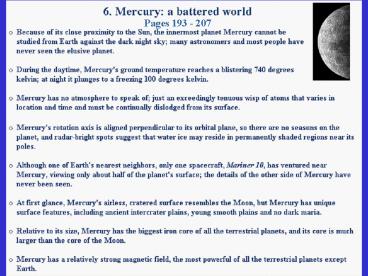P1254503547XUIzH PowerPoint PPT Presentation
Title: P1254503547XUIzH
1
Pages 193 - 207
2
Mariner 10 Mission to Mercury 1973 - 1974
3
Mariner 10 mosaics of Mercury (inbound left
outbound right
4
5
(No Transcript)
6
Average speed of gas molecules increase with
increasing T
7
The average speed of gas molecules decreases with
increasing mass. Note The escape velocity on
Mercury is 4.3 km/sec (or 10,000 miles/hour)
8
The average speed of gas molecules decreases with
increasing mass hence, H2 escapes more readily
from a planet than CO2.
9
Radius, mean density and interior structure of
the terrestrial planets
10
Mercury
Earth
2900 km
640 km
11
Caloris Basin 1,300 km in diameter
Rim crest
12
Effects of the formation of the Caloris Basin
13
Hilly and lineated terrain
14
Some craters on Mercury are quite young as they
have fresh-looking rays
Ray
15
Linear cliffs called scarps hundreds of km long
were probably caused by contraction and wrinkling
during cooling of the planet
16
Since the obliquity of Mercury is zero, its
rotational axis is perpendicular to is orbital
plane and, hence, areas in the polar regions are
permanently in the shade, suggesting that water
ice may be present?!
N. Pole
Arecibo radar antenna in Puerto Rico
Radar sounding of Mercury
17
http//messenger.jhuapl.edu/
Launched August 3rd, 2004 Venus fly-bys October
2006 and June 2007 Mercury fly-bys January 2008,
October 2008, September 2009 Orbits Mercury in
March 2011
18
5 Stages in the evolution of Mercury
- Formation, melting, and fractionation
(Fe,Ni-core, silicate mantle) 4.55 Gy ago - Planet-wide volcanism, cooling, formation of
lobate scarps - 4.5 to 4.0 Gy ago, heavy bombardment, and
formation of large basins like the Caloris Basin - Basaltic volcanism, filling of low-lying,
basin-like features - Minor impacts, regolith formation
19
Mercury summary
PowerShow.com is a leading presentation sharing website. It has millions of presentations already uploaded and available with 1,000s more being uploaded by its users every day. Whatever your area of interest, here you’ll be able to find and view presentations you’ll love and possibly download. And, best of all, it is completely free and easy to use.
You might even have a presentation you’d like to share with others. If so, just upload it to PowerShow.com. We’ll convert it to an HTML5 slideshow that includes all the media types you’ve already added: audio, video, music, pictures, animations and transition effects. Then you can share it with your target audience as well as PowerShow.com’s millions of monthly visitors. And, again, it’s all free.
About the Developers
PowerShow.com is brought to you by CrystalGraphics, the award-winning developer and market-leading publisher of rich-media enhancement products for presentations. Our product offerings include millions of PowerPoint templates, diagrams, animated 3D characters and more.

